Immobilization of Potentially Toxic Elements (PTE) by Mineral-Based Amendments: Remediation of Contaminated Soils in Post-Industrial Sites
Abstract
1. Introduction
2. Materials and Methods
2.1. Mineral-Based Amendments and Experimental Design
2.2. Soil from Post-Industrial Areas Used in the Experiment
2.3. Soil Analysis
2.4. Plant Material Analysis
2.5. Ecotoxicological Analysis
2.6. Statistical Analysis
3. Results
3.1. Soil Parameters
3.2. Soil Parameters after the Addition of Mineral-Based Amendments
3.3. Plant Growth after the Addition of Mineral-Based Amendments
3.4. PTE Accumulation in L. luteus
3.5. Chlorophyll Fluorescence
3.6. Leaf Greenness Index (SPAD)
3.7. Phytotoxicity
3.8. Statistical Analysis
4. Discussion
5. Conclusions
Author Contributions
Funding
Conflicts of Interest
References
- Christophoridis, C.; Bourliva, A.; Evgenakis, E.; Papadopoulou, L.; Fytianos, K. Effects of anthropogenic activities on the levels of heavy metals in marine surface sediments of the Thessaloniki Bay, Northern Greece: Spatial distribution, sources and contamination assessment. Microchem. J. 2019, 149, 104001. [Google Scholar] [CrossRef]
- Caridi, F.; Pappaterra, D.; Belmusto, G.; Messina, M.; Belvedere, A.; D’Agostino, M.; Settineri, L. Radioactivity and heavy metals concentration in Italian (Calabrian) DOC Wines. Appl. Sci. 2019, 9, 4584. [Google Scholar] [CrossRef]
- Tang, J.; Zhang, J.; Ren, L.; Zhou, Y.; Gao, J.; Luo, L.; Yang, Y.; Peng, Q.; Huang, H.; Chen, A. Diagnosis of soil contamination using microbiological indices: A review on heavy metal pollution. J. Environ. Manag. 2019, 242, 121–130. [Google Scholar] [CrossRef] [PubMed]
- Sas, W.; Dzięcioł, J.; Głuchowski, A. Estimation of recycled concrete aggregate’s water permeability coefficient as earth construction material with the application of an analytical method. Materials 2019, 12, 2920. [Google Scholar] [CrossRef]
- Odoh, C.K.; Zabbey, N.; Sam, K.; Eze, C.N. Status, progress and challenges of phytoremediation—An African scenario. J. Environ. Manag. 2019, 237, 365–378. [Google Scholar] [CrossRef] [PubMed]
- Li, Y.; Chiou, C.T.; Li, H.; Schnoor, J.L. Improved prediction of the bioconcentration factors of organic contaminants from soils into plant/crop roots by related physicochemical parameters. Environ. Int. 2019, 126, 46–53. [Google Scholar] [CrossRef] [PubMed]
- Luo, Y.; Wu, Y.; Shu, J.; Wu, Z. Effect of particulate organic matter fractions on the distribution of heavy metals with aided phytostabilization at a zinc smelting waste slag site. Environ. Pollut. 2019, 253, 330–341. [Google Scholar] [CrossRef] [PubMed]
- Castaldi, P.; Silvetti, M.; Manzano, R.; Brundu, G.; Roggero, P.P.; Garau, G. Mutual effect of Phragmites australis, Arundo donax and immobilization agents on arsenic and trace metals phytostabilization in polluted soils. Geoderma 2018, 314, 63–72. [Google Scholar] [CrossRef]
- Tauqeer, H.M.; Rahman, M.; Hussain, S.; Abbas, F.; Iqbal, M. The potential of an energy crop “Conocarpus erectus” for lead phytoextraction and phytostabilization of chromium, nickel, and cadmium: An excellent option for the management of multi-metal contaminated soils. Ecotoxicol. Environ. Saf. 2019, 173, 273–284. [Google Scholar] [CrossRef]
- Mahmoud, E.; Abd El-Kader, N. Heavy metal immobilization in contaminated soils using phosphogypsum and rice straw compost. Land Degrad. Dev. 2015, 26, 819–824. [Google Scholar] [CrossRef]
- Houben, D.; Pircar, J.; Sonnet, P. Heavy metal immobilization by cost-effective amendments in a contaminated soil: Effects on metal leaching and phytoavailability. J. Geochem. Explor. 2012, 123, 87–94. [Google Scholar] [CrossRef]
- Labidi, A.; Firmin, S.; Verdin, A.; Bidar, G.; Laruelle, F.; Douay, F.; Shirali, P.; Fontaine, J.; Sahraoui, A.L.H. Nature of fly ash amendments differently influences oxidative stress alleviation in four forest tree species and metal trace element phytostabilization in aged contaminated soil: A long-term field experiment. Ecotoxicol. Environ. Saf. 2017, 138, 190–198. [Google Scholar] [CrossRef] [PubMed]
- Waterlot, C.; Pruvot, C.; Marot, F.; Douay, F. Impact of a phosphate amendment on the environmental availability and phytoavailability of Cd and Pb in moderately and highly carbonated kitchen garden soils. Pedosphere 2017, 27, 588–605. [Google Scholar] [CrossRef]
- Parra, A.; Zornoza, R.; Conesa, E.; Gómez-López, M.D.; Faz, A. Seedling emergence, growth and trace elements tolerance and accumulation by Lamiaceae species in a mine soil. Chemosphere 2014, 113, 132–140. [Google Scholar] [CrossRef]
- Pardo, T.; Clemente, R.; Epelde, L.; Garbisu, C.; Bernal, M.P. Evaluation of the phytostabilisation efficiency in a trace elements contaminated soil using soil health indicators. J. Hazard. Mater. 2014, 268, 68–76. [Google Scholar] [CrossRef]
- Radziemska, M.; Gusiatin, Z.M.; Bilgin, A. Potential of using immobilizing agents in aided phytostabilization on simulated contamination of soil with lead. Ecol. Eng. 2017, 102, 490–500. [Google Scholar] [CrossRef]
- Fronczyk, J. Artificial road runoff water treatment by a pilot-scale horizontal permeable treatment zone. Ecol. Eng. 2017, 107, 198–207. [Google Scholar] [CrossRef]
- Fronczyk, J.; Radziemska, M.; Jeznach, J. Evaluation of diatomite and chalcedonite as reactive materials protecting groundwater in traffic infrastructure. Fres. Environ. Bull. 2014, 23, 3331–3339. [Google Scholar]
- Hermawan, A.A.; Chang, J.W.; Pasbakhsh, P.; Hart, F.; Talei, A. Halloysite nanotubes as a fine grained material for heavy metal ions removal in tropical biofiltration systems. Appl. Clay Sci. 2018, 160, 106–115. [Google Scholar] [CrossRef]
- Meng, Q.; Chen, H.; Lin, J.; Lin, Z.; Sun, J. Zeolite A synthesized from alkaline assisted pre-activated halloysite for efficient heavy metal removal in polluted river water and industrial wastewater. J. Environ. Sci. 2017, 56, 254–262. [Google Scholar] [CrossRef]
- Anastopoulos, I.; Mittal, A.; Usman, M.; Mittal, J.; Yu, G.; Núñez-Delgado, A.; Kornaros, M.A. review on halloysite-based adsorbents to remove pollutants in water and wastewater. J. Mol. Liq. 2018, 269, 855–868. [Google Scholar] [CrossRef]
- Lutyński, M.; Sakiewicz, P.; Lutyńska, S. Characterization of diatomaceous earth and halloysite resources of Poland. Minerals 2019, 9, 670. [Google Scholar] [CrossRef]
- Banaś, D.; Kubala-Kukuś, A.; Braziewicz, J.; Majewska, U.; Pajek, M.; Wudarczyk-Moćko, J.; Czech, K.; Garnuszek, M.; Słomkiewicz, P.; Szczepanik, B. Study of properties of chemically modified samples of halloysite mineral with X-ray fluorescence and X-ray powder diffraction methods. Radiat. Phys. Chem. 2013, 93, 129–134. [Google Scholar] [CrossRef]
- Pan, L.B.; Wang, S.Y.; Ma, J.; Fang, D. Gridded field observations of polycyclic aromatic hydrocarbons in soils from a typical county in Shanxi Province, China. Arch. Environ. Contam. Tox. 2015, 68, 323–329. [Google Scholar] [CrossRef]
- Regulation of the Minister of the Environment on September 2016 on the Standards of the Soil Quality and Ground Quality 1.09.2016, No 165, 1359; Polish Ministry of Environmental Protection: Warsaw, Poland, 2016. (In Polish)
- Liu, C.W.; Lin, K.H.; Kuo, Y.M. Application of factor analysis in the assessment of groundwater quality in a black foot disease area in Taiwan. Sci. Total Environ. 2003, 313, 77–89. [Google Scholar] [CrossRef]
- Lebrun, V.E.M.; Miard, F.; Nandillon, R.; Léger, J.C.; Hattab-Hambli, N.; Scippa, G.S.; Bourgerie, S.; Morabito, D. Assisted phytostabilization of a multi contaminated mine technosol using biochar amendment: Early stage evaluation of biochar feedstock and particle size effects on As and Pb accumulation of two Salicaceae species (Salix viminalis and Populus euramericana). Chemosphere 2018, 194, 316–326. [Google Scholar] [CrossRef]
- Radziemska, M.; Mazur, Z.; Fronczyk, J.; Matusik, J. Co-remediation of Ni-contaminated soil by halloysite and Indian mustard (Brassica juncea L.). Clay Min. 2016, 51, 489–497. [Google Scholar] [CrossRef]
- Radziemska, M. Study of applying naturally occurring mineral sorbents of Poland (dolomite, halloysite, chalcedonite) for aided phytostabilization of soil polluted with heavy metals. Catena 2018, 163, 123–129. [Google Scholar] [CrossRef]
- Radziemska, M.; Vaverková, M.D.; Baryła, A. Phytostabilization—Management strategy for stabilizing trace elements in contaminated soils. Int. J. Environ. Res. Public Health. 2017, 14, 958. [Google Scholar] [CrossRef]
- Hou, S.; Zheng, N.; Tang, L.; Ji, X.; Li, Y. Effect of soil pH and organic matter content on heavy metals availability in maize (Zea mays L.) rhizospheric soil of non-ferrous metals smelting area. Environ. Monit. Asses. 2019, 191, 634. [Google Scholar] [CrossRef]
- Blake, L.; Goulding, K.W.T. Effects of atmospheric deposition, soil pH and acidification on heavy metal contents in soils and vegetation of semi-natural ecosystems at Rothamsted Experimental Station, UK. Plant Soil 2002, 240, 235–251. [Google Scholar] [CrossRef]
- Jin, Y.; Liu, W.; Li, H.-L.; Shen, S.-G.; Liang, S.-X.; Liu, C.; Shan, L. Nano-hydroxyapatite immobilized lead and enhanced plant growth of ryegrass in a contaminated soil. Ecol. Eng. 2016, 95, 25–29. [Google Scholar] [CrossRef]
- Abad-Valle, P.; Álvarez-Ayuso, E.; Murciego, A.; Pellitero, E. Assessment of the use of sepiolite amendment to restore heavy metal polluted mine soil. Geoderma 2016, 280, 57–66. [Google Scholar] [CrossRef]
- Vardhan, K.H.; Kumar, P.S.; Panda, R.C. A review on heavy metal pollution, toxicity and remedial measures: Current trends and future perspectives. J. Mol. Liq. 2019, 290, 111197. [Google Scholar] [CrossRef]
- Ghazaryan, K.; Movsesyan, H.; Ghazaryan, N.; Watts, B.A. Copper phytoremediation potential of wild plant species growing in the mine polluted areas of Armenia. Environ. Pollut. 2019, 249, 491–501. [Google Scholar] [CrossRef]
- Radziemska, M.; Wyszkowski, M.; Bęś, A.; Mazur, Z.; Jeznach, J.; Brtnický, M. The applicability of compost, zeolite and calcium oxide in assisted remediation of acidic soil contaminated with Cr (III) and Cr (VI). Environ. Sci. Pollut. Res. 2019, 26, 21351–21362. [Google Scholar] [CrossRef]
- Rai, P.K.; Lee, S.S.; Zhang, M.; Tsang, Y.F.; Kim, K.H. Heavy metals in food crops: Health risks, fate, mechanisms, and management. Environ. Int. 2019, 125, 365–385. [Google Scholar] [CrossRef]
- Taghipour, M.; Jalali, M. Impact of some industrial solid wastes on the growth and heavy metal uptake of cucumber (Cucumis sativus L.) under salinity stress. Ecotoxicol. Environ. Saf. 2019, 182, 109347. [Google Scholar] [CrossRef]
- Kim, K.R.; Owens, G.; Kwon, S.I. Influence of Indian mustard (Brassica juncea) on rhizosphere soil solution chemistry in long-term contaminated soils: A rhizobox study. J. Environ. Sci. 2010, 22, 98–105. [Google Scholar] [CrossRef]
- Tian, S.; Liang, S.; Qiao, K.; Wang, F.; Zhang, Y.; Chai, T. Co-expression of multiple heavy metal transporters changes the translocation, accumulation, and potential oxidative stress of Cd and Zn in rice (Oryza sativa). J. Hazard. Mat. 2019, 380, 120853. [Google Scholar] [CrossRef]
- Lebrun, M.; De Zio, E.; Miard, F.; Scippa, G.S.; Renzone, G.; Scaloni, A.; Bourgerie, S.; Morabito, D.; Trupiano, D. Amending an As/Pb contaminated soil with biochar, compost and iron grit: Effect on Salix viminalis growth, root proteome profiles and metal(loid) accumulation indexes. Chemosphere 2020, 244, 125397. [Google Scholar] [CrossRef] [PubMed]
- Ying, M.; Yasuda, H.; Kobayashi, S.; Sakurai, N.; Kidou, S.I. Barley cold-induced CISP proteins contribute to the accumulation of heavy metals in roots. Environ. Exp. Bot. 2019, 165, 53–58. [Google Scholar] [CrossRef]
- Dabrowski, P.; Baczewska-Dabrowska, A.H.; Kalaji, H.M.; Goltsev, V.; Paunov, M.; Rapacz, M.; Wojcik-Jagla, M.; Pawluskiewicz, B.; Baba, W.; Brestic, M. Exploration of chlorophyll a fluorescence and plant gas exchange parameters as indicators of drought Tolerance in Perennial Ryegrass. Sensors 2019, 19, 2736. [Google Scholar] [CrossRef] [PubMed]
- Dabrowski, P.; Pawluskiewicz, B.; Kalaji, H.M.; Baczewska, A.H. The effect of light availability on leaf area index, biomass production and plant species composition of park grasslands in Warsaw. Plant Soil Environ. 2013, 59, 543–548. [Google Scholar] [CrossRef]
- Bes, A.; Warminski, K.; Adomas, B. Long-term responses of Scots pine (Pinus sylvestris L.) and European beech (Fagus sylvatica L.) to the contamination of light soils with diesel oil. Environ. Sci. Pollut. Res. 2019, 26, 10587–10608. [Google Scholar] [CrossRef]
- Hashemi, S.A. Studying the effects of heavy metal on chlorophyll and sugar in one year-old seedlings organs of Acer velutinum specie. Acta Ecol. Sin. 2018, 38, 224–227. [Google Scholar] [CrossRef]
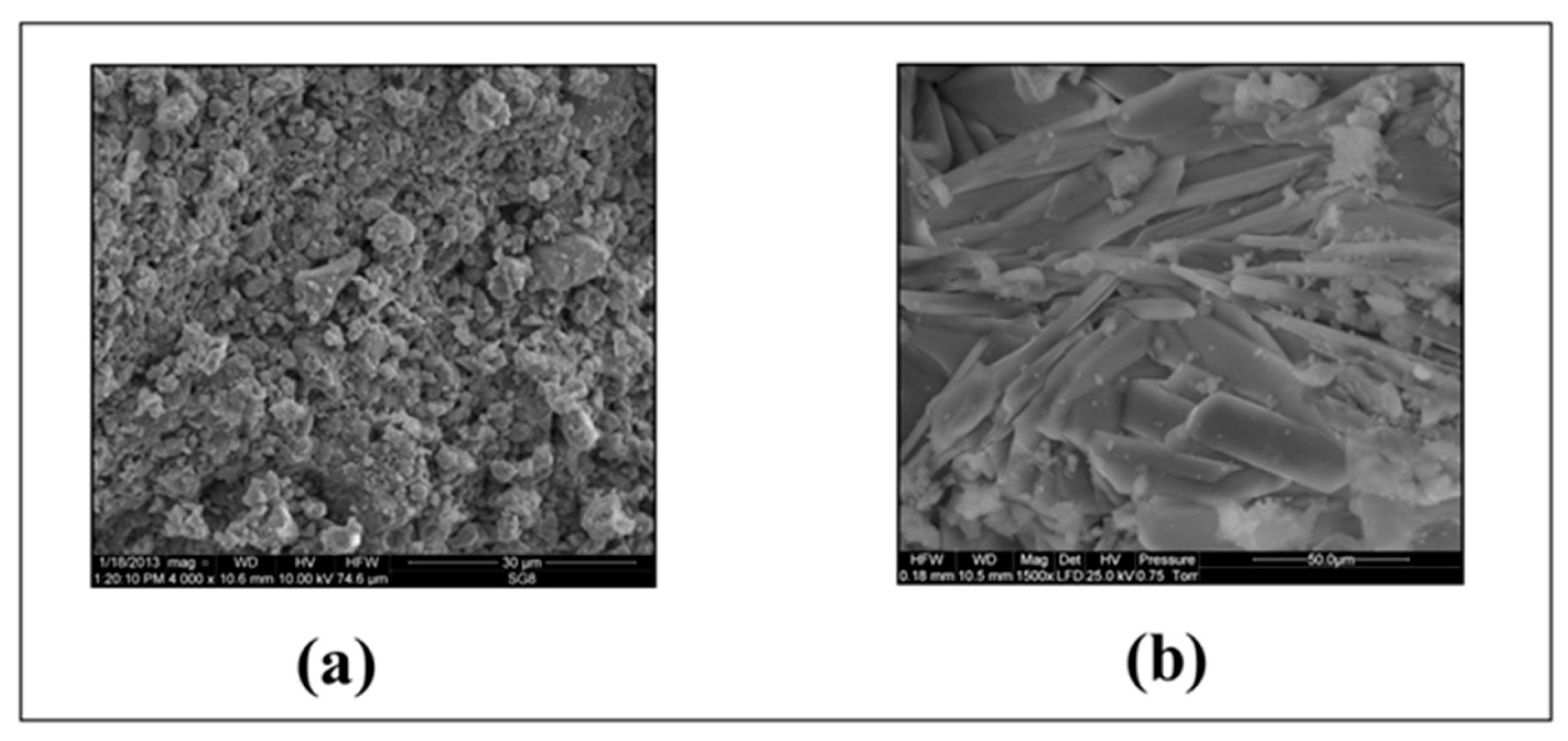
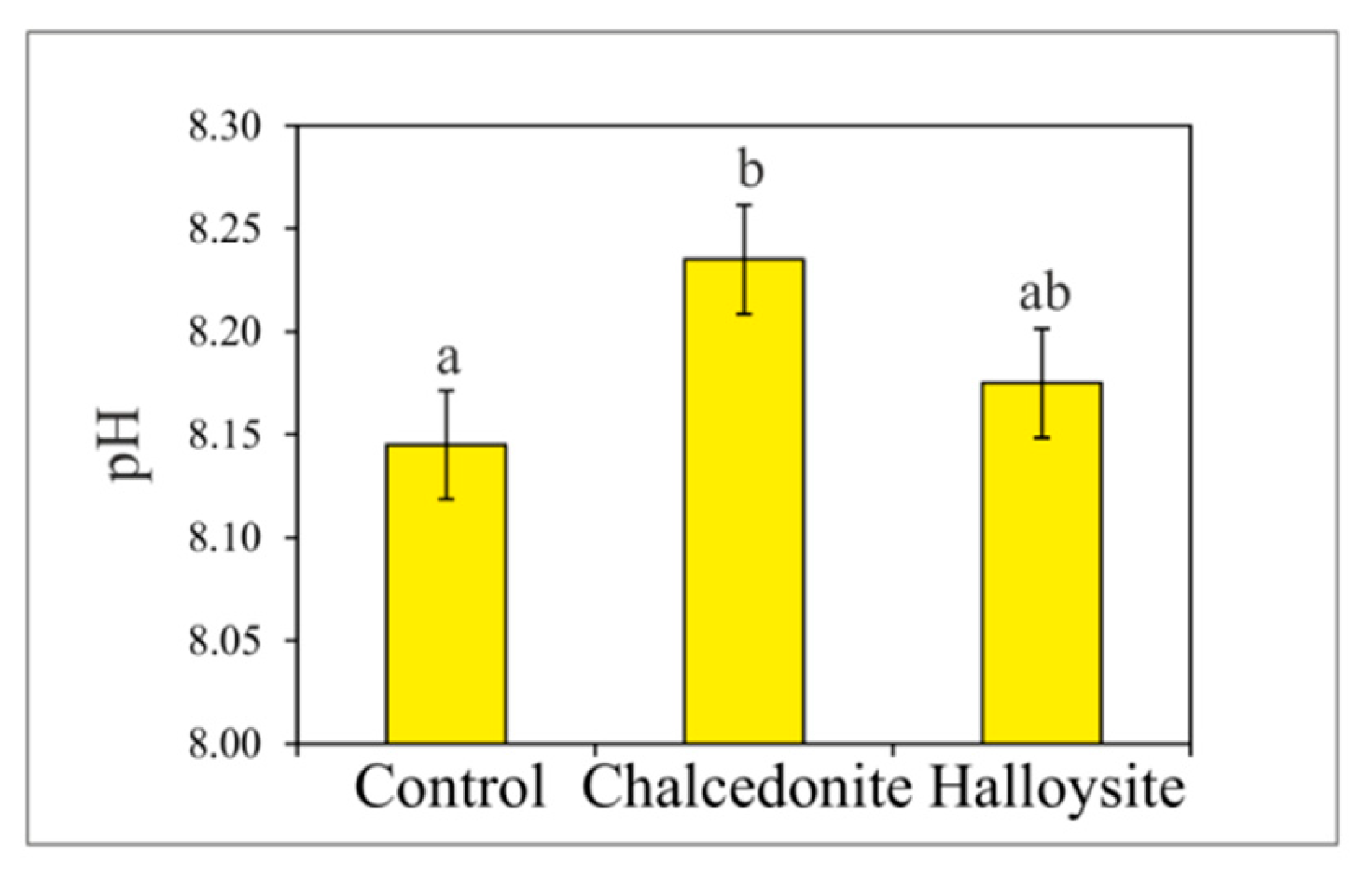
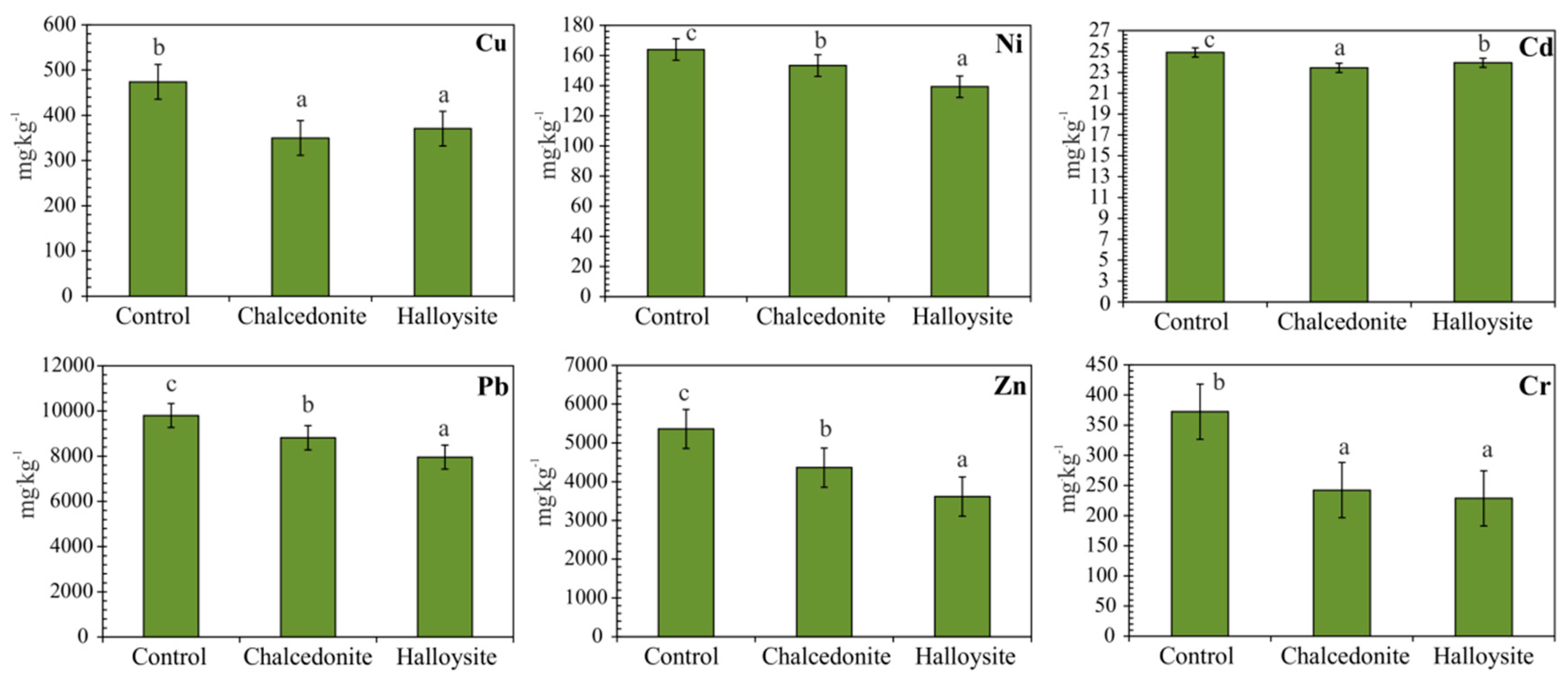

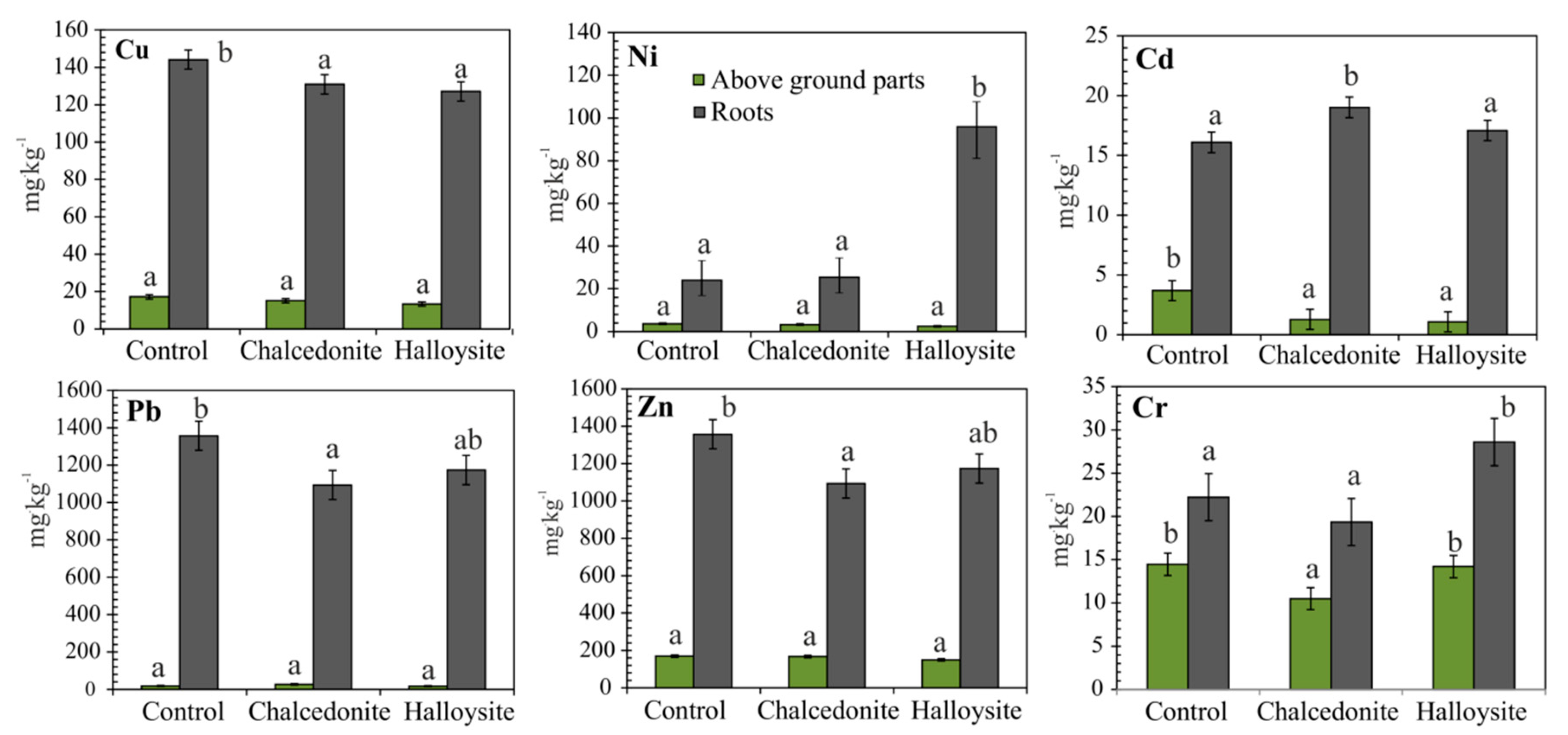
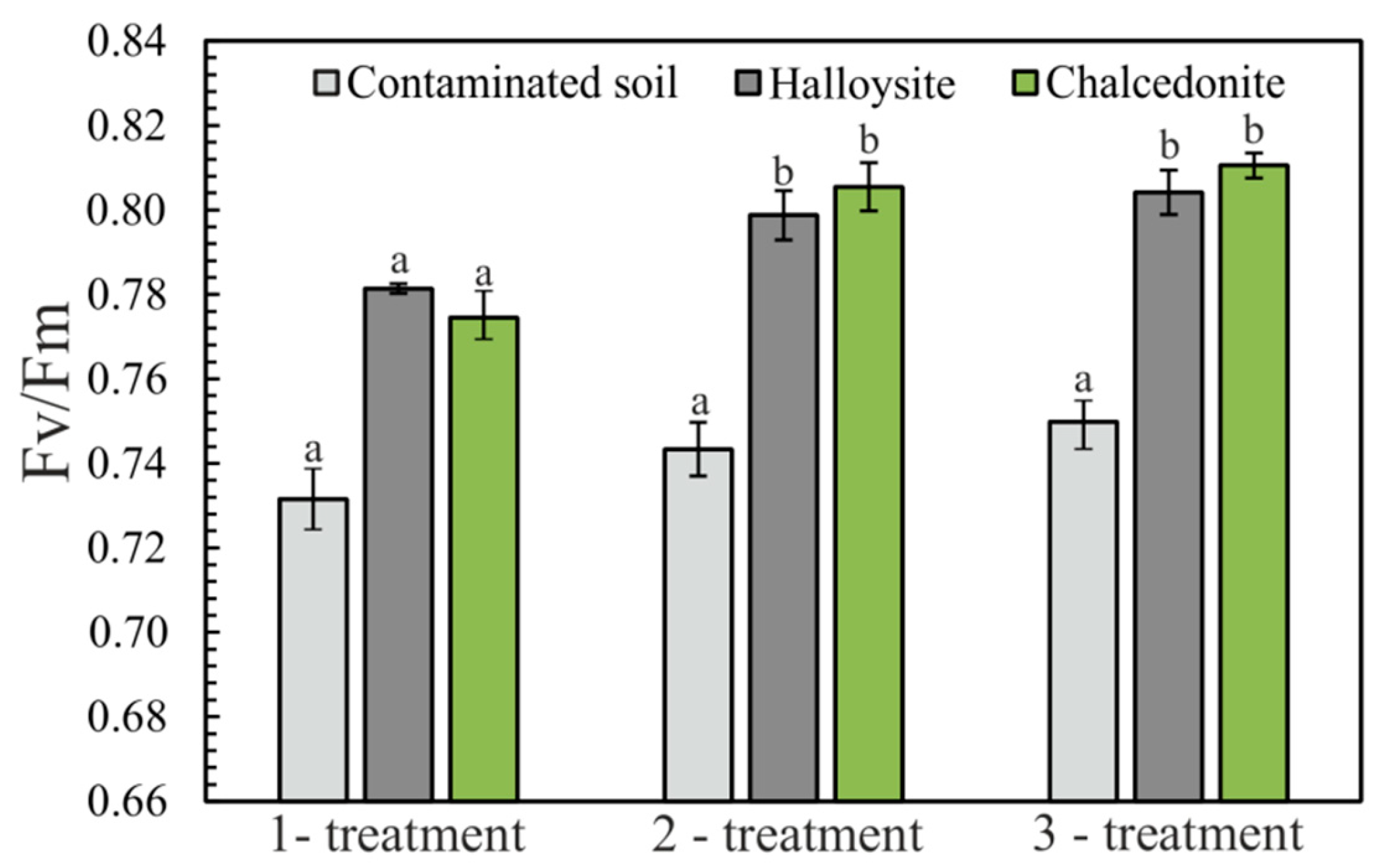
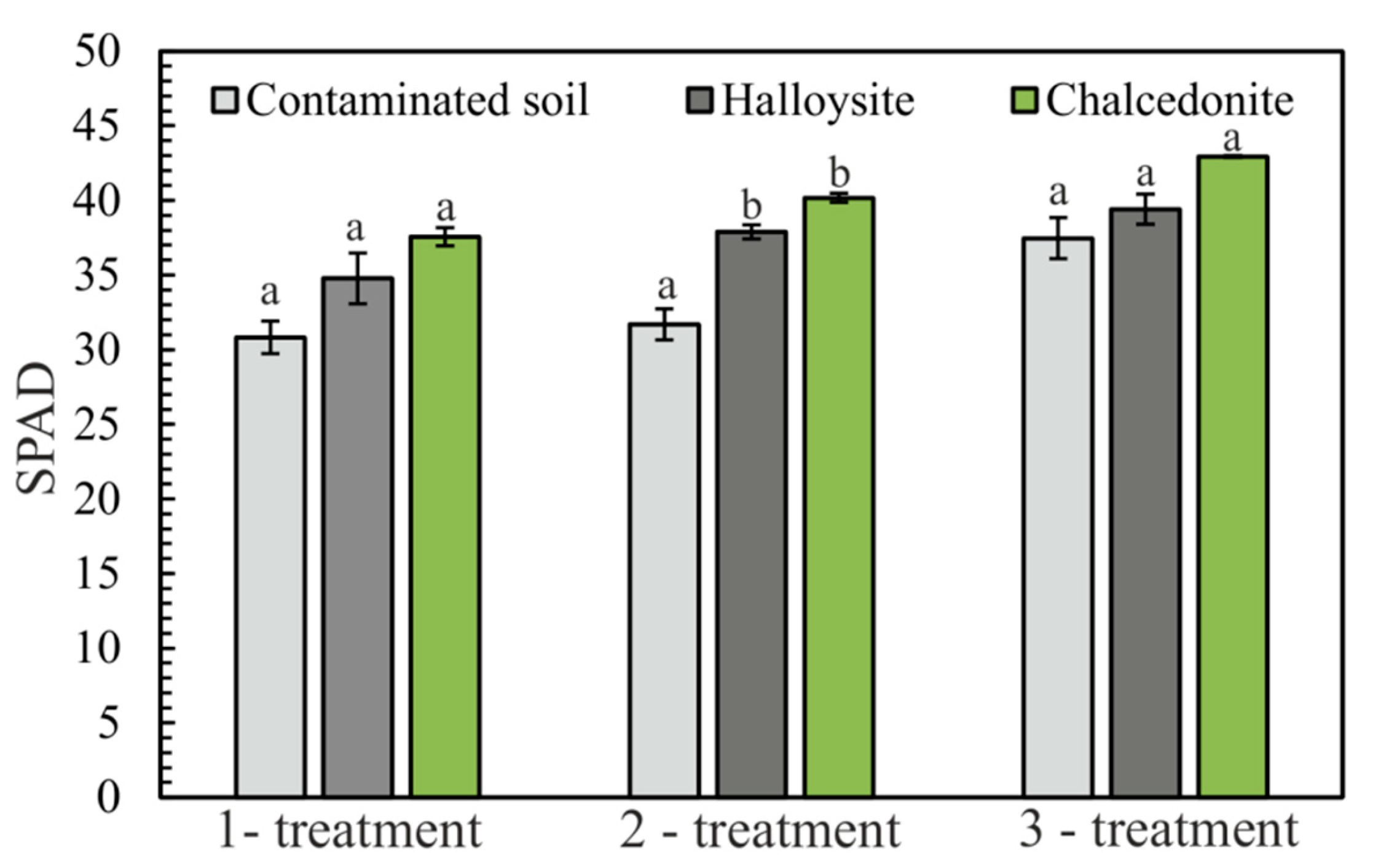
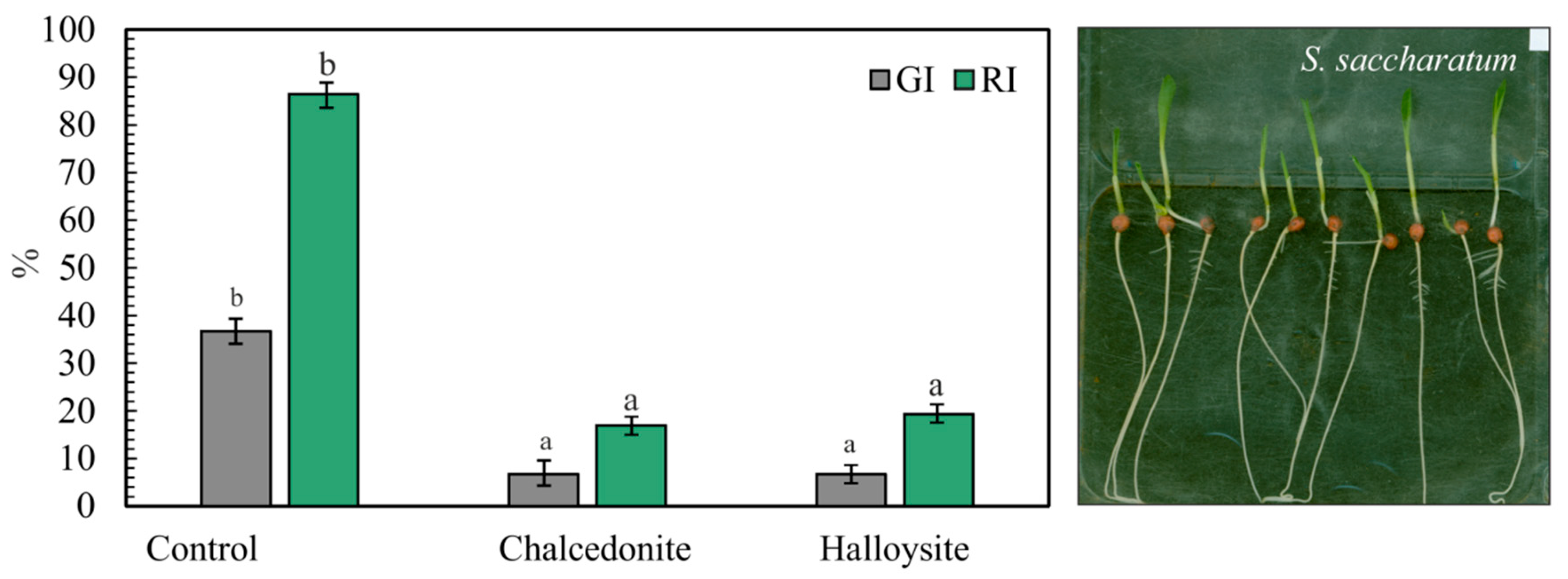
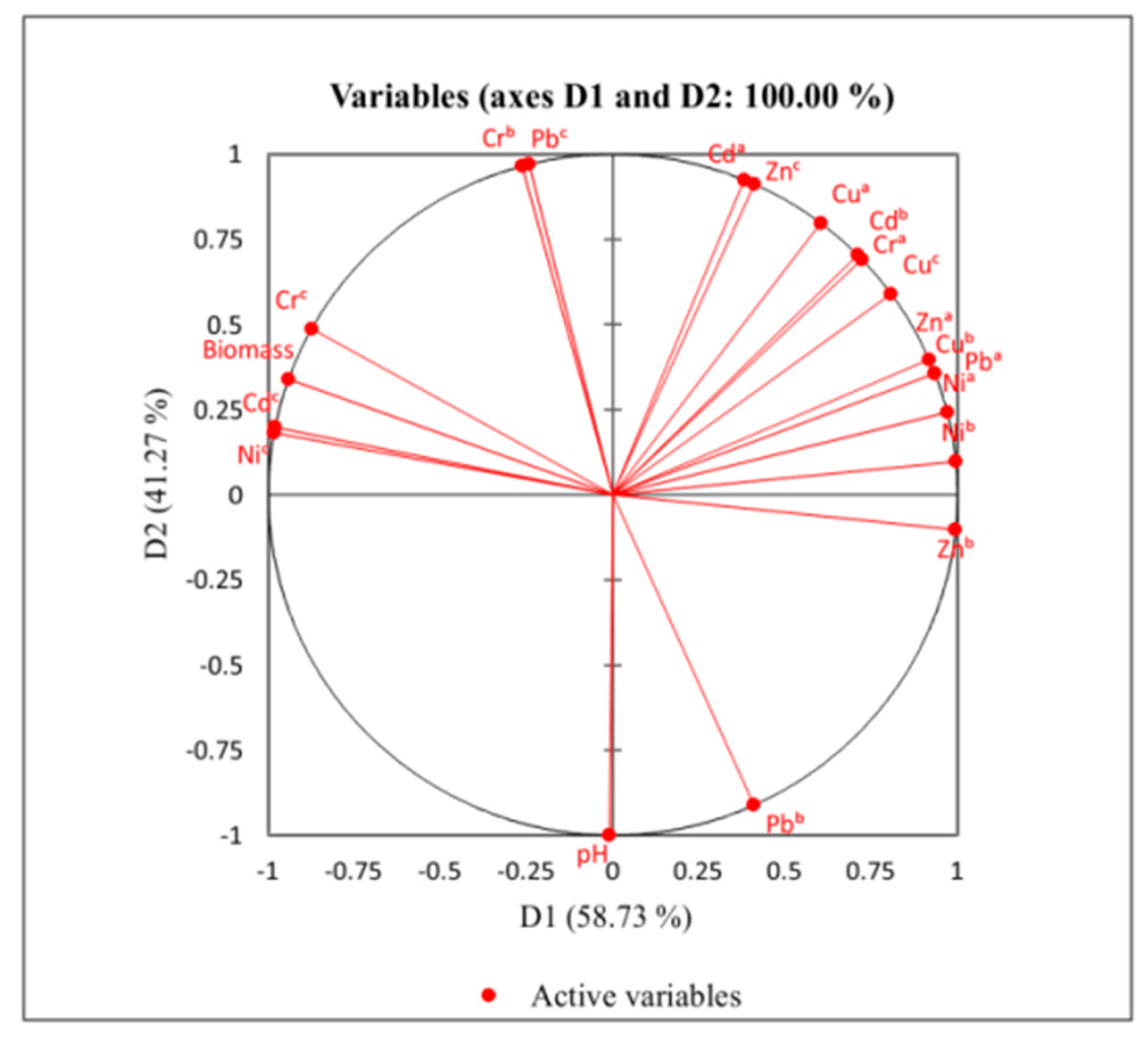
| Parameter | Chemical Composition in Oxide (wt. %) | Specific Surface Area (m2·g−1) | pH |
|---|---|---|---|
| Chalcedonite | SiO2—89.06 ± 0.46; Al2O5—9.33 ± 0.14; K2O—1.21 ± 0.08; MgO—0.40 ± 0.011 | 7.44 | 7.12 |
| Halloysite | SiO2—39.6, Al2O3—37.0, Fe2O3—16.1, TiO2—2.30, CaO—0.66, MgO—0.13, Na2O—0.04, K2—0.05; P2O5—0.52 | 75.0 | 7.66 |
| Parameter | Unit | Value | Acceptable Values a |
|---|---|---|---|
| pH | - | 7.54 ± 0.4 | - |
| Electrical conductivity | mS·cm−1 | 0.84 ± 0.3 | - |
| Organic matter | %·d.m. | 11 ± 2.1 | - |
| Cation Exchange Capacity | C mol (+)·kg−1 | 51.9 ± 2.7 | - |
| Cadmium (Cd) | mg·kg−1 | 22 ± 2.5 | 15 |
| Copper (Cu) | mg·kg−1 | 496 ± 144.4 | 600 |
| Chromium (Cr) | mg·kg−1 | 352 ± 61.1 | 500 |
| Nickel (Ni) | mg·kg−1 | 113 ± 24.5 | 300 |
| Lead (Pb) | mg·kg−1 | 13,540.0 ± 669.6 | 600 |
| Zinc (Zn) | mg·kg−1 | 8430 ± 1376.5 | 1000 |
| Variables | VF1 | VF2 |
|---|---|---|
| Biomass | −0.941 *** | 0.339 |
| pH | −0.010 | −1.000 * |
| Cu a | 0.604 | 0.797 *** |
| Cu b | 0.935 *** | 0.355 |
| Cu c | 0.808 *** | 0.589 |
| Ni a | 0.970 *** | 0.241 |
| Ni b | 0.995 *** | 0.097 |
| Ni c | −0.983 *** | 0.182 |
| Cd a | 0.382 | 0.924 *** |
| Cd b | 0.711 ** | 0.703 |
| Cd c | −0.980 *** | 0.198 |
| Pb a | 0.934*** | 0.356 |
| Pb b | 0.410 | −0.912 *** |
| Pb c | −0.243 | 0.970 *** |
| Zn a | 0.918 *** | 0.396 |
| Zn b | 0.995 *** | −0.103 |
| Zn c | 0.411 | 0.912 *** |
| Cr a | 0.723 ** | 0.690 |
| Cr b | −0.263 | 0.965 *** |
| Cr c | −0.874 *** | 0.486 |
| Eigenvalue | 12.634 | 7.366 |
| Variability (%) | 58.734 | 41.266 |
| Cumulative % | 58.734 | 100.000 |
© 2020 by the authors. Licensee MDPI, Basel, Switzerland. This article is an open access article distributed under the terms and conditions of the Creative Commons Attribution (CC BY) license (http://creativecommons.org/licenses/by/4.0/).
Share and Cite
Radziemska, M.; Bęś, A.; Gusiatin, Z.M.; Majewski, G.; Mazur, Z.; Bilgin, A.; Jaskulska, I.; Brtnický, M. Immobilization of Potentially Toxic Elements (PTE) by Mineral-Based Amendments: Remediation of Contaminated Soils in Post-Industrial Sites. Minerals 2020, 10, 87. https://doi.org/10.3390/min10020087
Radziemska M, Bęś A, Gusiatin ZM, Majewski G, Mazur Z, Bilgin A, Jaskulska I, Brtnický M. Immobilization of Potentially Toxic Elements (PTE) by Mineral-Based Amendments: Remediation of Contaminated Soils in Post-Industrial Sites. Minerals. 2020; 10(2):87. https://doi.org/10.3390/min10020087
Chicago/Turabian StyleRadziemska, Maja, Agnieszka Bęś, Zygmunt M. Gusiatin, Grzegorz Majewski, Zbigniew Mazur, Ayla Bilgin, Iwona Jaskulska, and Martin Brtnický. 2020. "Immobilization of Potentially Toxic Elements (PTE) by Mineral-Based Amendments: Remediation of Contaminated Soils in Post-Industrial Sites" Minerals 10, no. 2: 87. https://doi.org/10.3390/min10020087
APA StyleRadziemska, M., Bęś, A., Gusiatin, Z. M., Majewski, G., Mazur, Z., Bilgin, A., Jaskulska, I., & Brtnický, M. (2020). Immobilization of Potentially Toxic Elements (PTE) by Mineral-Based Amendments: Remediation of Contaminated Soils in Post-Industrial Sites. Minerals, 10(2), 87. https://doi.org/10.3390/min10020087







